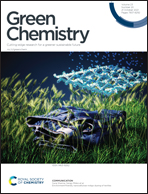Biological carbon fixation: a thermodynamic perspective†
Abstract
Biological carbon fixation has recently attracted global interest. Since reduction of CO2 is thermodynamically challenging, the aim of this review is to analyze the thermodynamic characteristics of ten natural, hybrid and synthetic carbon fixation pathways (CFPs), hoping to gain deeper insights into the biological carbon fixation. The changes of Gibbs free energy of each reaction involved in the ten CFPs were calculated and thoroughly analyzed. Six natural CFPs could be classified into energy-intensive and energy-saving categories. In general, CFPs in aerobic microorganisms are thermodynamically more feasible than those in anaerobic ones. Interestingly, the thermodynamically unfeasible step was not always consistent with the biological rate-limiting step, which was usually determined by the low activity of the enzyme. Moreover, the essentiality of combining the availability of intracellular ATP and reducing equivalents for carbon fixation was investigated from a thermodynamic perspective. Among all the CFPs analyzed, synthetic CFPs have smaller thermodynamic barriers and require less ATP input. Based on these comparative analyses, suggestions for designing and constructing more efficient CFPs were proposed.

- This article is part of the themed collections: 2021 Green Chemistry Hot Articles, Green Chemistry Reviews and CO2 Utilisation


 Please wait while we load your content...
Please wait while we load your content...